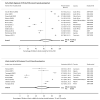Missed opportunities to prevent mother-to-child-transmission: systematic review and meta-analysis
- PMID: 22948267
- PMCID: PMC3741537
- DOI: 10.1097/QAD.0b013e328359ab0c
Missed opportunities to prevent mother-to-child-transmission: systematic review and meta-analysis
Abstract
Objectives: To determine magnitude and reasons of loss to program and poor antiretroviral prophylaxis coverage in prevention of mother-to-child transmission (PMTCT) programs in sub-Saharan Africa.
Design: Systematic review and meta-analysis.
Methods: We searched PubMed and Embase databases for PMTCT studies in sub-Saharan Africa published between January 2002 and March 2012. Outcomes were the percentage of pregnant women tested for HIV, initiating antiretroviral prophylaxis, having a CD4 cell count measured, and initiating antiretroviral combination therapy (cART) if eligible. In children outcomes were early infant diagnosis for HIV, and cART initiation. We combined data using random-effects meta-analysis and identified predictors of uptake of interventions.
Results: Forty-four studies from 15 countries including 75,172 HIV-infected pregnant women were analyzed. HIV-testing uptake at antenatal care services was 94% [95% confidence intervals (CIs) 92-95%] for opt-out and 58% (95% CI 40-75%) for opt-in testing. Coverage with any antiretroviral prophylaxis was 70% (95% CI 64-76%) and 62% (95% CI 50-73%) of pregnant women eligible for cART received treatment. Sixty-four percent (95% CI 48-81%) of HIV exposed infants had early diagnosis performed and 55% (95% CI 36-74%) were tested between 12 and 18 months. Uptake of PMTCT interventions was improved if cART was provided at the antenatal clinic and if the male partner was involved.
Conclusion: In sub-Saharan Africa, uptake of PMTCT interventions and early infant diagnosis is unsatisfactory. An integrated family-centered approach seems to improve retention.
Figures




References
-
- UNAIDS . Global report, fact sheet, sub-Saharan Africa. 2010.
-
- WHO . PMTCT Strategic Vision 2010-2015: Preventing mother-to-child transmission of HIV to reach the UNGASS and Millenium Development Goals. 2010.
-
- WHO . Programatic update, Use of Antiretroviral Drugs for Treating Pregnant Women and Preventing HIV Infection in Infants, Executive summary. 2012.
-
- WHO . Prevention of Mother-To-Child Transmission (PMTCT), Briefing Note. 2007.
Publication types
MeSH terms
Substances
Grants and funding
LinkOut - more resources
Full Text Sources
Other Literature Sources
Medical
Research Materials

